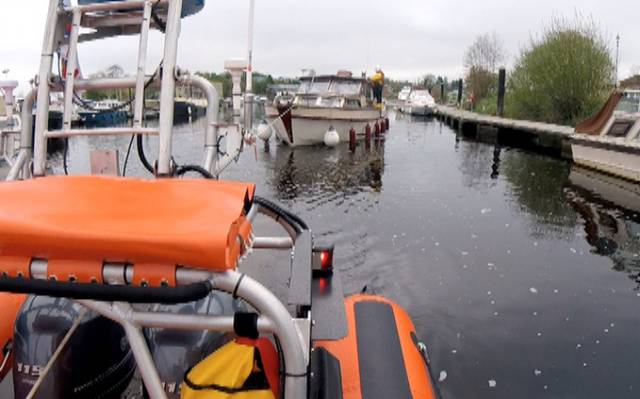#RNLI - Carrybridge RNLI’s inshore lifeboat launched yesterday morning (Sunday 6 May) following a request by Belfast Coastguard to assist a 37ft cruiser taking on water on the lough near Belturbet, Co Cavan.
The lifeboat Douglas Euan & Kay Richards, with helm Chris Cathcart, David Reid, Kyle Boyd and Colin Beacom on board, launched at 7.28am from Upper Lough Erne in Co Fermanagh and arrived shortly after in Belturbet.
Winds were southerly, Force 1 and visibility was good with sunny skies.
The lifeboat crew located the casualty vessel moored alongside the public jetty, but still taking on water. Belturbet Fire and Rescue Service were also in attendance. The owner and his dog were unharmed.
The RNLI volunteer crew set up their salvage pump, and started to pump the water out of the casualty vessel. Once the water level started to lower, the access point of the water was located and a temporary seal put in place.
The casualty vessel was then pumped out dry, and the lifeboat towed it to the public slipway where it was beached to avoid it sinking. The lifeboat departed the scene at 9.40am.
Following the callout, Cathcart said: “The crew were glad to be able to assist the owner this morning with his vessel, and hope he continues to have an enjoyable holiday.”
Much earlier on Sunday, the Portrush all-weather lifeboat crew in Co Antrim happened upon a casualty on land after a callout was stood down.
Three volunteer crew — Karl O’Neill, Jason Chambers and Ben Durrant — were returning home after the 1.40am call when they discovered a man who had fallen and had suffered significant injures to the face.
The crew dialled 999 to request assistance. O’Neill, who is also an RNLI lifeguard supervisor, had his responder bag to hand and was able to administer first aid to stop the bleeding from the casualty’s face. Durrant then took the casualty to the local emergency department for further treatment.
Keith Gilmore Portrush RNLI lifeboat operations manager, commented: “Once again our volunteer crew have shown that the skills and training they have received as lifeboat crew members can be applied to assist in any situation.
“I am very proud that the men on their way home at 2am stopped to help a member of the public who was obviously injured and in distress. We wish him a full recovery.”
































































